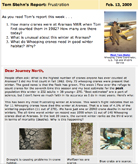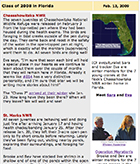Today's Report Includes:
- Welcome! >>
- Where Are They Now? Visit the Wintering Grounds (Slide Shows) >>
- News: Reports From the Field >>
- Journal Question: Why Leg Bands? >>
- Coming Soon: Track the Migration!>>
-
Links: This Week's Crane Resources >>
Photo Sara Zimorski
We're glad you're here for a new journey north! The tallest bird in North America has something special to "whoop" about, and so do the people who work so hard to save this species. Why?
-
The number of whoopers in the natural Western flock reached another high. But what is the year's biggest worry?
-
The new Eastern flock has 20 juveniles safely on their wintering grounds. They include 14 ultralight-led birds and 6 Direct Autumn Release (DAR) birds. Unaided, will they all find their way back north?
When we look back on spring 2009, what will we remember and celebrate? Stay tuned.

An estimated 266 are in Texas. >>
Hunkered
down today on their wintering grounds are the world's wild
migratory Whooping cranes. The 87 birds of the Eastern flock are wintering
in Florida Georgia, South Carolina, Tennessee, Alabama, with one in
Indiana. Take a visit with our photo shows!

The Class of 2008 is in Florida. >>
 |
||
|
News! >> |
The
Class of 2008's fall migration just ended last month. |
News! >> |
|
Welcome back to the crane experts who bring us the news! In Texas with the original natural flock, Tom Stehn tells status and stories of the whoopers he's observed for over 30 years. In Florida watching over the Class of 2008 are Sara, Eva, Brooke and Bev. They will share photos, crane mischief, and news. What's the latest word? |
||
Attaching colored bands with radio transmitters to the legs of the Eastern flock's chicks is a big event every year. Banding is done by experts during a health check. The wild-born chicks in the Western flock are not banded.
- For what reasons might scientists put leg bands on the chicks of the new Eastern flock? What could they learn from banding these birds?
Write your ideas in your Journey North Whooping Crane Journal. >>
Starting
in March, you'll see the migration progress of both flocks —
ALL the world's migratory Whooping cranes — live
on our MapServer! |
||
| Click for migration animation >> | Click
for migration animation >> |
|
- Teachers: Getting Started >>
- Summary Chart: The Class of 2008's Ultralight-led Journey South >>
- Review: Key Timline Events for the Class of 2008 >>
- Background: St. Marks: A Second Winter Home >>
- Banding: Leg Bands: Codes and Colors >>
- Listening: How Does a Whooping Crane Sound? >>
- Meet Craniacs: Classrooms in Action >>
The Next Whooping Crane Migration Update Will Be Posted on February 27, 2009.










